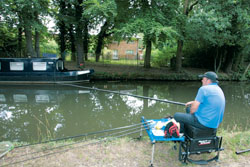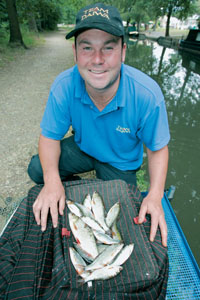| Will in action on the Basingstoke Canal |
 |
A lot of people don’t like the
I really enjoy fishing it even if I am only aiming for a pound or two. For me it’s just very good fun. What is more, I have learned so much from this place about fishing hard venues and trying to winkle out a few extra fish from here, there and everywhere rather than just packing up and going home.
That in itself has helped my match fishing with Daiwa Dorking and Drennan Team
The canal also holds a lot of sentimental value for me, as it is the venue where I caught my first-ever fish. Every one remembers their first fish and where they caught it, don’t they? The fish that started my angling career was a small roach and came from a swim opposite
The lake is controlled by the military and there are rumoured to be 40lb carp in there. What is true is that the towpath swims opposite the lake do hold many big fish and are popular with pleasure anglers and an excellent match draw.
I used to go to the canal and fish after school with my mates. Those were good days and it is also the venue that first saw me break into the match scene, when I experienced my first big winter league campaigns with Farnborough. I have fished quite a few matches on the canal over the years since then, and many were very rewarding experiences, but I do recall the satisfaction I gained from one early winter league event where I won my section.
I remember we were tying on points with
Generally the canal has areas where small fish can be hard to come by, but hold lots of quality fish like carp, tench and big bream. These areas require a patient but positive approach looking for fewer bites but aiming to land most fish hooked. However, there are sections where there are good numbers of roach and skimmers and these rank among my favourites. Just up from the Mytchett Lake section is Potters, opposite the restaurant of the same name. It’s an unusual place as canal barges can pull into the restaurant’s own mooring area.
I took the Match Fishing cameras just up from the restaurant almost opposite a park, but that was for a good reason.
| Will has fond memories of this venue and proves there are still some good fisih to be had. |
 |
In park-side waters you usually find that people regularly feed the ducks and waterfowl with bread. These areas of canals are also usually the home of moored houseboats, so any fish in these areas are also ‘fed’ on a daily basis on bread and scraps not eaten by the birds. Therefore, if you are drawn in these areas in summer, you can expect a lot of fish to be present and that punched bread will probably be the most effective bait.
I could tell this area was going to be reasonable as I walked along the canal, because I could see fish topping and there was definitely more activity in this area than most. In this situation, on a relatively narrow canal where there may be far bank disturbance from sky liners, I look to fish in the deepest part of the swim, which I reckon to be at around seven metres here, and where I expect to find three to four feet of water. I like to feed just one line and concentrate all the fish in that area.
If you have houseboats moored along the far bank you will often find that a deeper hole can be located at the rear end where the engines are. This is because the engines stir up the bottom when they start up. It’s not so important in summer but in winter it can be the place to concentrate on.
So it’s one-line work really and you don’t need loads of rigs for bread punch fishing. I like the Drennan Pinkie float pattern, which has a nice positive bristle that adequately supports the weight of the punched bread hook bait. This is important, otherwise the bristle will start to give you false bites as the bread swells and takes on water. Sizes range from 4×10 to 4×14, the choice really depending on the depth of the water. My line choice is Daiwa Matchwinner 0.10mm main line to 0.07mm diameter Daiwa Spectron hook length. A size 18 Kamasan B511 is my very favourite bread punch hook although sometimes when bream and skimmers are about I will step up to a size 16, but I won’t go smaller than a 20.
The punch rig is shotted using a small bulk of No11s, each with a little gap between them, and below that are three No11 droppers – this is quite a positive pattern because sometimes you will be on a lot of fish and then you need to be able to read the float properly to avoid striking at liners. The elastic I have been using lately for this scale of work is the Kamasan grade 4, which is nice and soft – just right.
For hook baits I like to use a fresh, medium-sliced white loaf of bread straight from the bag. I use the Drennan brass-headed punches and generally start off with the 4mm size. From that I would not expect to vary punch size very much, if at all, but as the session goes on and if the fishing gets harder smaller bits of punch can work better. Conversely, bigger bits of punch can sometimes be better as they are more visible, especially in clear water canals.
In my opinion you can’t beat liquidised white bread for feed bait. I prefer it to punch crumb because it stays moist much longer and can be squeezed together easily, but sinks in a lingering cloud. I use freshly liquidised medium sliced bread, as the thick cut is too thick for the hooker slices. For a summer session on the canal I would prepare nearly two whole loaves after putting a few slices aside for the hook baits. I use a blender to make very fine particles of bread so that the bread on the hook will stand out more.
I would normally put the bread through the blender the night before, but if I am fishing a local water I’m happy do it in the morning – it’s the freshness that counts. For those reasons I don’t like to freeze any leftovers.
To feed, at the start I would introduce a harder-squeezed cupful and a looser one to create more of a cloud. Thereafter I like to throw in a pinch by hand at regular intervals to keep the fish in the area.
In a swim like this one, where plumbing up reveals between three and four feet of water, I set the rig to start just off the bottom about three inches short of full depth. I will vary this and shallow up further to catch maybe as much as 10 inches off bottom. In winter on the bread punch I would expect a quick burst of feeding fish right at the beginning of the match and then it would get harder, but in the summer you can often catch all day from one line on the punch if the fish are having a go.
Although I try to keep to one area of feed, if bites do dry up one trick I have learned on this canal is to drop the rig in well away from the feed but on the same line. I have caught a lot of fish doing this over the years and it’s a way of catching a few extra fish while resting the main area of the peg at the same time. If my initial area of feed dries up completely and I can’t scrape any more bites I am not afraid of fishing further down the canal and even re-feeding to start again if I have to.
Sometimes the fish will back off a bit and you just can’t get them back. If the punch really dies, squatts and casters come into play. Then, loose feeding squatts across can tempt the odd fish. Casters are usually there for the big fish on this canal but you can flick a few down the peg ‘mid-cut’ or against a boat looking to pick up one or two bonus fish later on.
You can usually expect a fish first put-in on the punch and that happened on this occasion with a small roach obliging. Then I enjoyed a steady hour catching similar sized fish before a boat came through and churned up the bottom. This was a problem that required re-feeding, but the very first fish I had after the boat was my best roach of the day. The fishing then got harder and it became apparent that the fish had backed off further down towards the park where the bird feeders were concentrated – you could see the fish topping!
I re-fed against a boat and had a few more fish and also picked some off from areas away from the feed, but eventually it became a case of scratching them out. I ended up with a few pounds of fish in a few hours. Winkling out these sorts of weights is good practice to keep you sharp.
Venue Fact File
Basingstoke
Access: For Mytchett Lake Bridge to Mytchett Place Road Bridge(Mytchett) there is parking for about 12 cars just over Mytchett Lake Bridge, or park in the Canal Centre.
Controlled by:
Contact: Club secretary Jeff Bunch 01252 326421.
Tickets: Annual individual permits £18 adults, £9 concessions; day tickets £3 in advance, £4 on the bank for adults, or £2 and £3 respectively for concessions. Monthly tickets are available (2005).
Match Fishing





